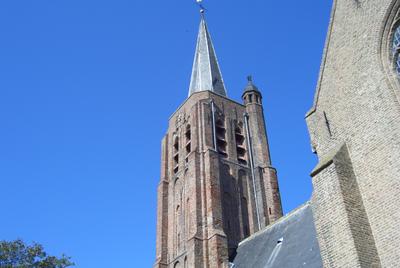Nisse’s village plan follows a layout common in Zeeland, based on a series of nested circles: the church stands at the very center. It is surrounded by a green commons, which comprises the center of the village. The one in Nisse has a small pond that freezes in the wintertime, thereby turning into a skating rink. The houses are arranged around the periphery of the green, so that each house faces the church. The backyards of the houses are wedge-shaped, so that the footprint of the entire village is round, with a church at the center, and the gardens shaped like pieces of pizza with one bit taken out of each.

The tower of the Church at Nisse was built in 1421, and the first part of the nave quickly followed. The whole thing is made of brick. What interests me in particular about the Church at Nisse is that it has several wall paintings, which all date from the last decades of the fifteenth century, but were painted over during the iconoclasm of the sixteenth century (probably in about 1572). The whitewash was lifted in the 1920s to reveal a giant image depicting St. Christopher.

The mural is painted on the north interior wall of the church’s original nave (the building was extended in the sixteenth century). The image is difficult to make out now, because it has been severely damaged since its discovery in the early 20th century. Above all, direct light from the windows in south wall has bleached the bottom of the mural. The image depicts St. Christopher ferrying the Christ child across a raging torrent. At the upper right side of the image, a hermit holds a lantern to guide the giant to the other side.
The image of St. Christopher probably appeared on most pre-Reformation church interiors: gazing upon the saint promised extraordinary spiritual and physical benefits and therefore provided great impetus to come to church. Such promises are codified in a rubric prefacing a prayer to St. Christopher in a 15th-century Dutch prayerbook (which I’ve translated for you):
rub: "The Privileges of St. Christopher. St. Ambrose describes that St. Christopher the holy martyr converted more then 75,000 people to believe in Christ. Therefore, anyone who looks at his image in the honor of Christ, and in honor of his divine service reads a pater noster and an Ave Maria every day, on that day he will not die unconfessed, nor without the sacrament, nor a bad death. Furthermore, he will be protected on water and on land against all Turkish weapons, against enemies, against bad air, against pestilence, against hunger, against hail, wind, thunder, lightening, bad diseases, and against enemies’ spiritual and burning machinations, both seen and unseen, and against anything that might harm him."
St. Christopher became the patron of travelers, not only because he safely transported the Christ child across a dangerous river, but because he promised all kinds of protections against perils that might befall a traveler. It’s not wonder that cab drivers in many countries (mostly Catholic ones) hang an image of St. Christopher on the rearview mirror, even though the saint was decanonized. The only church still dedicated to him—tellingly—is one right near the Citroen plant outside Paris.
No comments:
Post a Comment